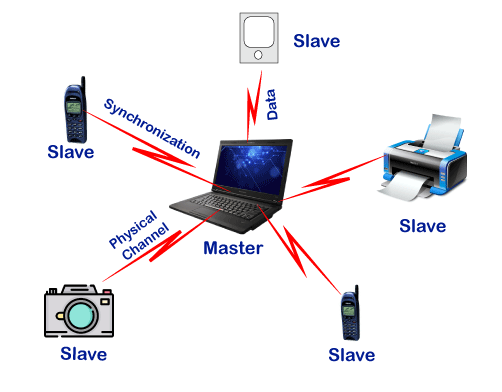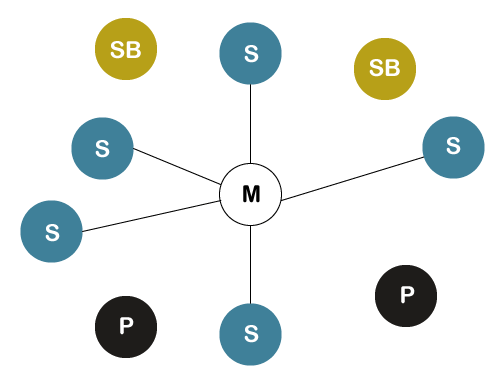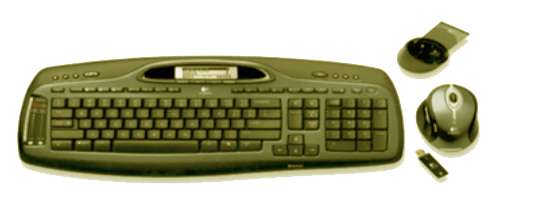Bluetooth Technology in Mobile Computing
Bluetooth technology is a high speed and low powered wireless technology designed to connect phones or other portable equipment for communication or file transmissions. This is based on mobile computing technology. Following is a list of some prominent features of Bluetooth technology:
- Bluetooth is also known as IEEE 802.15 standard or specification that uses low power radio communications to link phones, computers and other network devices over a short distance without using any type of connecting wires.
- As Bluetooth is an open wireless technology standard so, it is used to send or receive data to connected devices present across a certain distance using a band of 2.4 to 2.485 GHz.
- In Bluetooth technology, the wireless signals transmit data and files over a short distance, typically up to 30 feet or 10 meters.
- Bluetooth technology was developed by a group of 5 companies known as Special Interest Group formed in 1998. The companies are Ericsson, Intel, Nokia, IBM, and Toshiba.
- The range of Bluetooth technology for data exchange was up to 10 meters in older versions of devices, but the latest version of Bluetooth technology i.e., Bluetooth 5.0, can exchange data in the range of about 40-400 meters.
- The average speed of data transmission in Bluetooth technology was around 1 Mbps in the very first version. The second version was 2.0+ EDR, which provided the data rate speed of 3Mbps. The third was 3.0+HS, which provided the speed of 24 Mbps. The latest version of this technology is 5.0.
History of Bluetooth
There is an amazing story behind the history of Bluetooth technology. The Bluetooth wireless technology was named after a Danish King named Harald Blatand. His last name means "Bluetooth" in English. The name "Bluetooth" was awarded to this technology because the Danish King named Harald Blatand was united the Denmark and Norway, same as Bluetooth wireless technology is used to unite two disparate devices for communication or data transmission.
Ericsson Mobile Communications started the development of Bluetooth technology in 1994. The main motive behind the development of this amazing technology was to find an alternative to the use of cables for communication between mobile phones and other devices. In 1998, 4 big companies of that time named Ericsson, IBM, Nokia and Toshiba formed the Bluetooth Special Interest Group (SIG), which published the 1st version of Bluetooth technology in 1999. After that, four versions have been released. The latest version of this technology is Bluetooth 5.0.
The Architecture of Bluetooth Technology
- In Bluetooth technology, the network of Bluetooth consists of a Personal Area Network or a
- Bluetooth's architecture is also called a "Piconet" because it is made of multiple networks.
- It contains a minimum of 2 to a maximum of 8 Bluetooth peer devices.
- It usually contains a single master and up to 7 slaves.
- Piconet provides the technology which facilitates data transmission based on its nodes, i.e., Master node and Slave Nodes.
- The master node is responsible for sending the data while the slave nodes are used to receive the data.
- In Bluetooth technology, data transmission occurs through Ultra-High frequency and short-wavelength radio waves.
- The Piconet uses the concept of multiplexing and spread spectrum. It is a combination of code division multiple access (CDMA) and frequency hopping spread spectrum (FHSS) technique.
How does Bluetooth work?
As we stated that there is one master and up to 7 slaves may exist for a Bluetooth connection. The master is the device that initiates communication with other devices. The master device handles the communications link and traffic between itself and the slave devices associated with it. The slave devices have to respond to the master device and synchronize their transmit/receive timing with the master device's specified time.

Conditions for Successful Data transmission
Following is a list of some conditions that must be satisfied for a successful data transmission in Bluetooth technology:
- Maximum number of Master Node - 1
- Maximum number of Slave Nodes - 7
- Maximum number of Nodes in a Piconet - 8
- Maximum number of devices that can be paired - 28 - 1 = 255
- Number of devices that can be parked → Infinite (∞)

Explanation
- The parked node is a type of node that is ready to be connected and stand by node is a type of node that can either become a slave or parked node or remains idle or disconnected.
- In Bluetooth technology, the data transmission can only occur between master and slave nodes. It cannot be done between slave and slave nodes. However, two master nodes can be connected.
- If the connection from the master node gets disconnected, the whole Piconet gets disconnected.
- If there is a connection between two master nodes, then that network is called as Scatter-net.
- It means scatter-nets are created when a device becomes an active member of more than one Piconet and the adjoining device shares its time slots among the different piconets.
- If the number of slaves or devices is increased in a Piconet, then the data transmission speed will be decreased, and if the number of slaves or devices is decreased in number, then the data transmission speed will be increased.
Specifications of Bluetooth Technology
Bluetooth technology can be specified in two types:
- The Core Specification
- The Pro?les Speci?cation
The Core Specifications
The core specification is used to define the Bluetooth protocol stack and the requirements for the testing and qualification process of the Bluetooth-based products.
The core specification of Bluetooth Technology contains 5 layers:
- Radio: It is used to specify the requirements for radio transmission such as frequency, modulation, and power characteristics for a Bluetooth transceiver.
- Baseband Layer: It is used to define physical and logical channels, voice or data link types, various packet formats, transmit and receive timing, channel control, and the mechanism for frequency hopping and device addressing. It also specifies point to point or point to multipoint links. The length range of a packet can vary from 68 bits to a maximum of 3071 bits.
- Link Manager Protocol (LMP): The Link manager protocol is used to de?ne the procedures for link set up and ongoing link management.
- Logical Link Control and Adaptation Protocol (L2CAP): It is used for adapting upper-layer protocols to the baseband layer.
- Service Discovery Protocol (SDP): It facilitates the Bluetooth device to query other Bluetooth devices for device information, provided services, and the characteristics of those services.
Here, the first three layers denote the Bluetooth module, whereas the last two layers make up the host. The interface between these two logical groups is called the Host Controller Interface.
The Pro?les Speci?cation
It provides usage models to show detailed information about using the Bluetooth protocol for various types of applications.
Advantages of Bluetooth Technology
Following is a list of some advantages of the Bluetooth technology:
- Bluetooth Technology is based on Wireless technology. That's why it is cheap because it doesn't need any transmission wire that reduces the cost.
- It is very simple to form a Piconet in Bluetooth technology.
- It removes the problem of radio interference by using the Speed Frequency Hopping technique.
- The energy or power consumption is very low, about 0.3mW. It makes it possible for the least utilization of battery life.
- It is robust because it guarantees security at a bit level. The authentication is controlled using a 128bit key.
- You can use it for transferring the data, and verbal communication as Bluetooth can support data channels of up to 3 similar voice channels.
- It doesn't require line of sight and one to one communication as used in other modes of wireless communications such as infrared.
Disadvantages of Bluetooth Technology
Following is a list of some disadvantages of the Bluetooth technology:
- In Bluetooth technology, the bandwidth is low.
- The data transmission range may also be an issue because it is also less.
Applications of Bluetooth Technology
Bluetooth technology is used in many communicational and entertainment devices. The following are some most used applications of the Bluetooth technology:
- Bluetooth technology is used in cordless desktop. It means the peripheral devices such as a mouse, keyboard, printer, speakers, etc. are connected to the desktop without a wire.

- It is used in the multimedia transfer, such as exchanging multimedia data like songs, videos, pictures etc. that can be transferred among devices using Bluetooth.
- This technology is also used in the following devices: i.e.
- Bluetooth Speakers.
- Bluetooth Headphones.
- Bluetooth Headsets for calling purposes.
- Bluetooth gaming consoles etc.
|


 For Videos Join Our Youtube Channel: Join Now
For Videos Join Our Youtube Channel: Join Now











